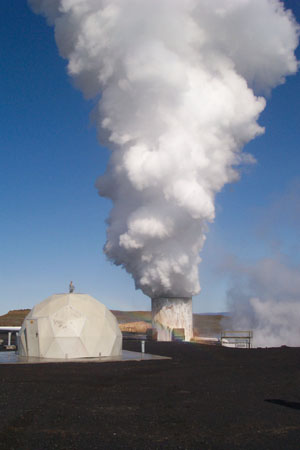Borehole
Borehole refers to a narrow shaft bored in the ground, either vertically or horizontally. Boreholes are drilled for various purposes, including the extraction of water, oil, gas, or other mineral resources, as well as for scientific research and environmental monitoring. The process of creating a borehole is known as drilling, which requires specialized equipment and techniques depending on the depth, geological conditions, and the purpose of the borehole.
Types of Boreholes[edit | edit source]
Boreholes can be classified based on their intended use or the method used to drill them. Some common types include:
- Water Wells: These are drilled to access groundwater for drinking, irrigation, or industrial use.
- Oil and Gas Wells: These boreholes are drilled to explore and extract petroleum and natural gas from underground reservoirs.
- Geotechnical Boreholes: Used for investigating soil properties and geology for construction and engineering projects.
- Environmental Monitoring Wells: Installed to monitor groundwater quality and to detect contamination.
- Geothermal Wells: Drilled to harness geothermal energy from the Earth's heat.
Drilling Techniques[edit | edit source]
Several techniques are employed in borehole drilling, each suited to specific conditions and purposes:
- Rotary Drilling: A common method for deep boreholes, using a rotating drill bit to cut through rock.
- Percussion Drilling: Involves repeatedly dropping a heavy tool in the borehole to break up rock or soil.
- Cable Tool Drilling: An older method where a heavy steel cable is used to lift and drop a drill bit.
- Directional Drilling: Allows drilling at various angles to reach targets not directly below the drill site.
Components of a Borehole[edit | edit source]
A typical borehole consists of several components to ensure its stability and functionality:
- Casing: A tube or pipe installed in the borehole to prevent the walls from collapsing and to isolate groundwater zones.
- Drill Bit: The cutting tool at the end of the drill string that breaks and removes the rock or soil.
- Drill String: A column of drill rods that transmits rotational force to the drill bit.
- Mud System: Circulates drilling fluid to cool the drill bit, remove cuttings, and maintain pressure.
Environmental and Safety Considerations[edit | edit source]
Borehole drilling and operation must consider environmental protection and safety measures:
- Water Contamination: Proper casing and sealing are essential to prevent surface contaminants from entering groundwater.
- Land Disturbance: Minimizing the footprint of drilling operations to reduce impact on ecosystems.
- Blowouts: Installing blowout preventers and other safety equipment to control unexpected releases of oil, gas, or drilling fluid.
Applications[edit | edit source]
Beyond resource extraction and environmental monitoring, boreholes have applications in:
- Scientific Research: Studying Earth's subsurface, climate history, and geological processes.
- Geothermal Energy Production: Using the Earth's heat for power generation and heating.
- Subsurface Storage: Storing substances like CO2 or natural gas underground.
Search WikiMD
Ad.Tired of being Overweight? Try W8MD's physician weight loss program.
Semaglutide (Ozempic / Wegovy and Tirzepatide (Mounjaro / Zepbound) available.
Advertise on WikiMD
|
WikiMD's Wellness Encyclopedia |
| Let Food Be Thy Medicine Medicine Thy Food - Hippocrates |
Translate this page: - East Asian
中文,
日本,
한국어,
South Asian
हिन्दी,
தமிழ்,
తెలుగు,
Urdu,
ಕನ್ನಡ,
Southeast Asian
Indonesian,
Vietnamese,
Thai,
မြန်မာဘာသာ,
বাংলা
European
español,
Deutsch,
français,
Greek,
português do Brasil,
polski,
română,
русский,
Nederlands,
norsk,
svenska,
suomi,
Italian
Middle Eastern & African
عربى,
Turkish,
Persian,
Hebrew,
Afrikaans,
isiZulu,
Kiswahili,
Other
Bulgarian,
Hungarian,
Czech,
Swedish,
മലയാളം,
मराठी,
ਪੰਜਾਬੀ,
ગુજરાતી,
Portuguese,
Ukrainian
Medical Disclaimer: WikiMD is not a substitute for professional medical advice. The information on WikiMD is provided as an information resource only, may be incorrect, outdated or misleading, and is not to be used or relied on for any diagnostic or treatment purposes. Please consult your health care provider before making any healthcare decisions or for guidance about a specific medical condition. WikiMD expressly disclaims responsibility, and shall have no liability, for any damages, loss, injury, or liability whatsoever suffered as a result of your reliance on the information contained in this site. By visiting this site you agree to the foregoing terms and conditions, which may from time to time be changed or supplemented by WikiMD. If you do not agree to the foregoing terms and conditions, you should not enter or use this site. See full disclaimer.
Credits:Most images are courtesy of Wikimedia commons, and templates, categories Wikipedia, licensed under CC BY SA or similar.
Contributors: Prab R. Tumpati, MD






